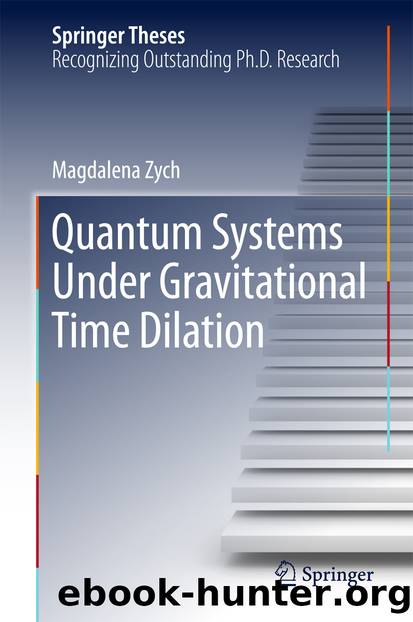Quantum Systems under Gravitational Time Dilation by Magdalena Zych

Author:Magdalena Zych
Language: eng
Format: epub
Publisher: Springer International Publishing, Cham
5.3 General Relativistic and Quantum Aspects of the Proposals
The aim of the proposed experiments is to access a physical regime where the effects stemming from both quantum mechanics and general relativity (GR) cannot be neglected. To this end, experimental results should simultaneously falsify a model of quantum fields or particles evolving in a Newtonian potential and a model of classical fields or particles in curved space-time (see Fig. 5.5). Below it is analysed in which sense and how this can be achieved.
The effect of gravity can also be detected by observing a shift in the relative phase between the superposed amplitudes travelling along the two arms, in both massive, Sect. 5.1.2, and massless, Sect. 5.2.2, case. The observation of the phase shift alone could not be directly interpreted as a test of the time dilation, since it can be understood in terms of a coupling between the mass and a potential in a flat space-time, which would yield the same phase shift without the time dilation. There is a formal analogy between a massive particle in the Newtonian limit of gravity and a charged particle in a Coulomb electrostatic potential. In the latter, the notion of proper time unquestionably never enters, which suggests that only those gravitational effects which have no electrostatic analogues can be seen as genuinely general relativistic, in the present interferometric context. The gravitational phase shift effect does have an electrostatic analogue experimentally verified with electrons in a Coulomb potential, see e.g. [13]. Thus measurements of the gravitational phase-such alone, such as those of Refs. [6, 11], do not contradict non-metric, Newtonian gravity and cannot be seen as tests of general relativity. The interaction of photons with the Newton potential, however, requires an additional ingredient: it is necessary to assign an effective gravitational mass to the photon, whereas massless particles, or electromagnetic waves, do not interact with gravity in the non-relativistic mechanics. Such an interaction is a direct consequence of the mass-energy equivalence.
More precisely, the interaction necessary to obtain the gravitational phase shift follows from postulating the equivalence between the system’s mass and its average total energy, i.e. that internal energy contributes to the system’s rest mass: , where is the non-gravitational Hamiltonian of the system. This yields a gravitational energy term
Download
This site does not store any files on its server. We only index and link to content provided by other sites. Please contact the content providers to delete copyright contents if any and email us, we'll remove relevant links or contents immediately.
The Complete Stick Figure Physics Tutorials by Allen Sarah(7338)
Secrets of Antigravity Propulsion: Tesla, UFOs, and Classified Aerospace Technology by Ph.D. Paul A. Laviolette(5333)
Thing Explainer by Randall Munroe(3910)
The River of Consciousness by Oliver Sacks(3572)
The Order of Time by Carlo Rovelli(3162)
How To by Randall Munroe(3074)
A Brief History of Time by Stephen Hawking(2992)
I Live in the Future & Here's How It Works by Nick Bilton(2960)
What If?: Serious Scientific Answers to Absurd Hypothetical Questions by Randall Munroe(2670)
The Great Unknown by Marcus du Sautoy(2662)
Midnight in Chernobyl by Adam Higginbotham(2516)
Blockchain: Ultimate Step By Step Guide To Understanding Blockchain Technology, Bitcoin Creation, and the future of Money (Novice to Expert) by Keizer Söze(2467)
Networks: An Introduction by Newman Mark(2382)
The Meaning of it All by Richard Feynman(2319)
Easy Electronics by Charles Platt(2308)
The Tao of Physics by Fritjof Capra(2247)
Midnight in Chernobyl: The Untold Story of the World's Greatest Nuclear Disaster by Adam Higginbotham(2196)
When by Daniel H Pink(2098)
Introducing Relativity by Bruce Bassett(2097)
